Are you looking to add more greenery to your indoor space? Pothos plants are not only easy to care for but also a breeze to propagate, which means you can create an abundance of lush plants from a single parent plant. In this blog post, we’ll walk you through the various methods of how to propagate pothos, from water and soil propagation to sphagnum moss and other techniques. So roll up your sleeves and get ready to multiply your pothos collection!

Short Summary
Propagate pothos cuttings in water or soil for a lush garden.
Prepare stem cuttings and apply rooting hormone to give them a head start!
Follow proper care instructions for successful propagation & vibrant growth!
Ideal Time for Pothos Propagation

Spring and summer are the perfect seasons for propagating pothos plants. Why? Because during these months, pothos plants experience active growth, making it an ideal time for them to develop roots. So, as you prepare to propagate your pothos cuttings, keep in mind that timing is crucial for success.
On the other hand, it’s best to avoid propagating pothos in fall and winter. The mother plant may have difficulty recovering from having stem cuttings taken during these months. So save your propagation plans for the warmer months, and you’ll be well on your way to creating a lush, green oasis.
Propagating Pothos in Water
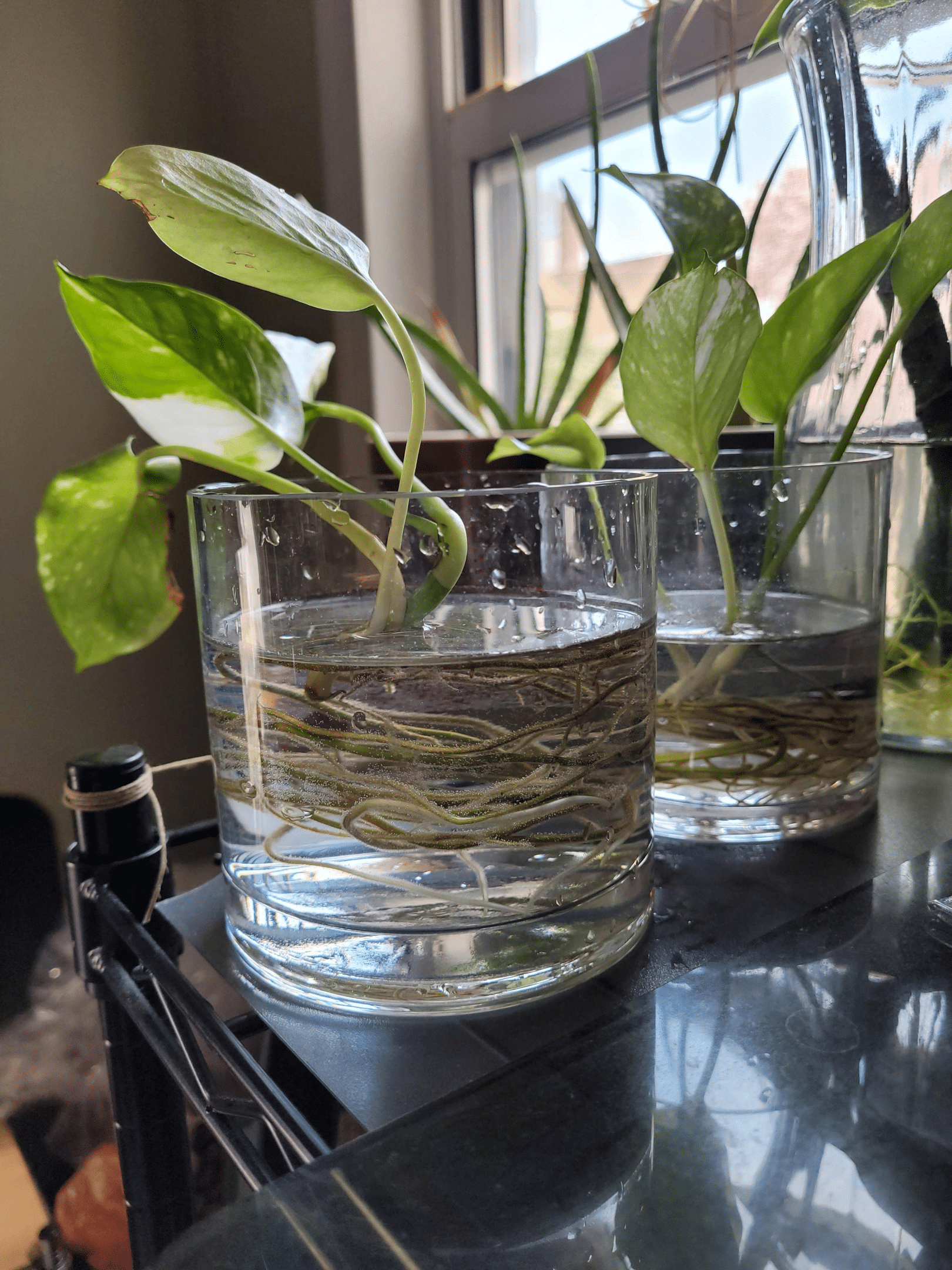
Water propagation is a popular and straightforward method for pothos. With just a few simple steps, you can transform stem cuttings into vibrant, new plants. Not only will you enjoy watching the roots grow, but you’ll also have the satisfaction of knowing you’ve nurtured new life from an existing plant. So let’s dive into the fascinating world of water propagation!
In the following sections, we’ll discuss how to prepare stem cuttings, care for them in water, and eventually transfer them to soil once they have developed roots. You’ll soon see why water propagation is a favorite among plant enthusiasts!
Preparing Stem Cuttings
To begin, you’ll need to select a healthy stem from your pothos plant. Cut the stem 4-5 inches from the tip, leaving the last leaf at the tip of the stem. This ensures a strong start for your new cutting. Make sure your cutting has 3-4 nodes (the points where leaves and aerial roots grow).
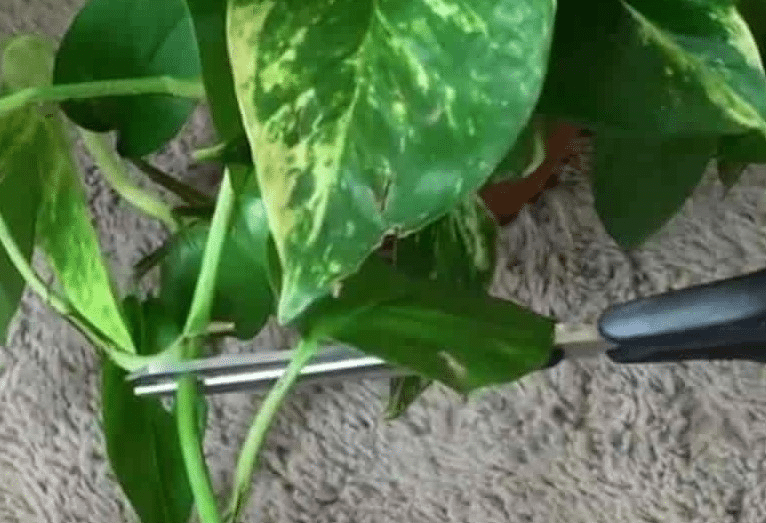
Once you’ve obtained your cutting, it’s time to remove the bottom leaves. This will help encourage new growth. You have two options for removing the stems. You can cut them off or pull them gently.
Now that your stem cutting is prepared, it’s time to move on to the next step: caring for the cutting in water.
Caring for Cuttings in Water
For successful water propagation, it’s essential to submerge at least one or two nodes in water, without submerging any leaves. To ensure optimal growth, keep the cuttings in fresh water and change the water once a week. Place the cuttings in a bright location with indirect light to promote root growth.
Remember, patience is key! It’s thrilling to watch the roots grow, but it might take around 10 days before you start seeing the initial signs of root formation. Keep a close eye on your cuttings and enjoy the process of nurturing new life.
Transferring Rooted Cuttings to Soil
Once the roots have grown to a length of 1-2 inches, it’s time to transfer your cuttings to soil. Start by placing about one to two inches of soil in the bottom of a pot with drainage holes. Next, gently rinse the rooted cutting with fresh water and place it in the pot, covering the roots with soil. Leave about an inch of space at the top of the pot. To ensure good contact between the roots and the soil, gently press the soil around the plant.
Congratulations! You’ve successfully propagated your pothos cutting in water and transferred it to soil. Now, all that’s left is to care for your new plant as it continues to grow and thrive.
Propagating Pothos in Soil
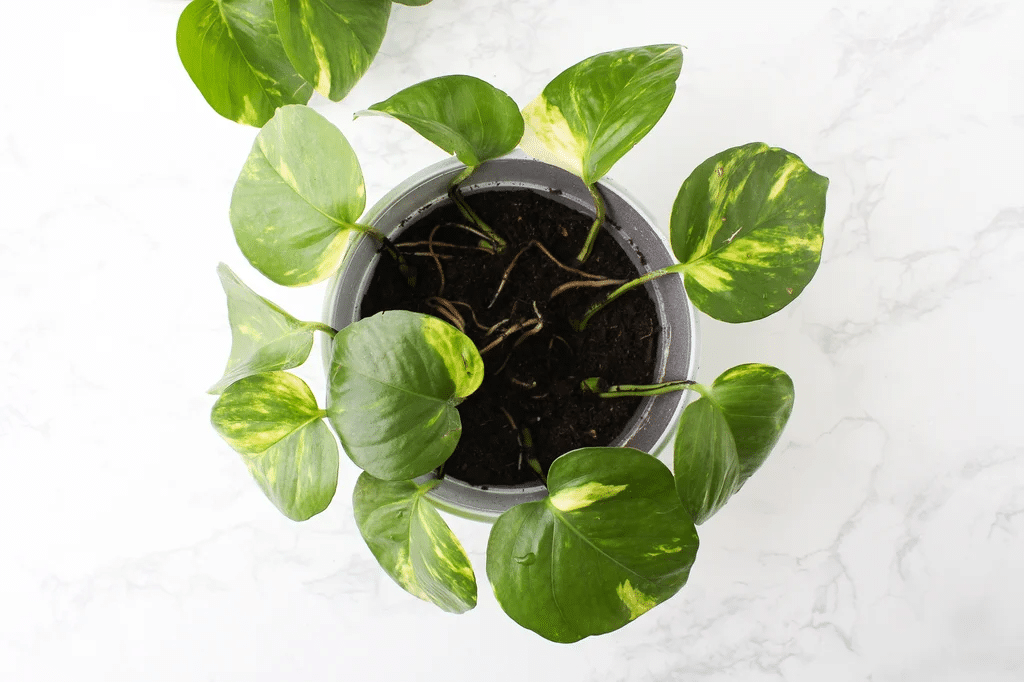
Another method to propagate pothos plants, besides propagating pothos in water, is to propagate pothos in soil by planting stem cuttings directly into it. This technique can result in stronger root systems compared to water propagation. While it may take a bit longer for the cuttings to root, the end result is often worth the wait.
In this section, we’ll guide you through the process of preparing stem cuttings, applying rooting hormone, and planting and caring for cuttings in soil. Let’s get started!
Preparing Stem Cuttings
As mentioned in section 2.1, prepare the stem cuttings from the parent plant by cutting a 4-5 inch section with 3-4 nodes and removing the bottom leaves.
This process is the same for both water and soil propagation.
Applying Rooting Hormone
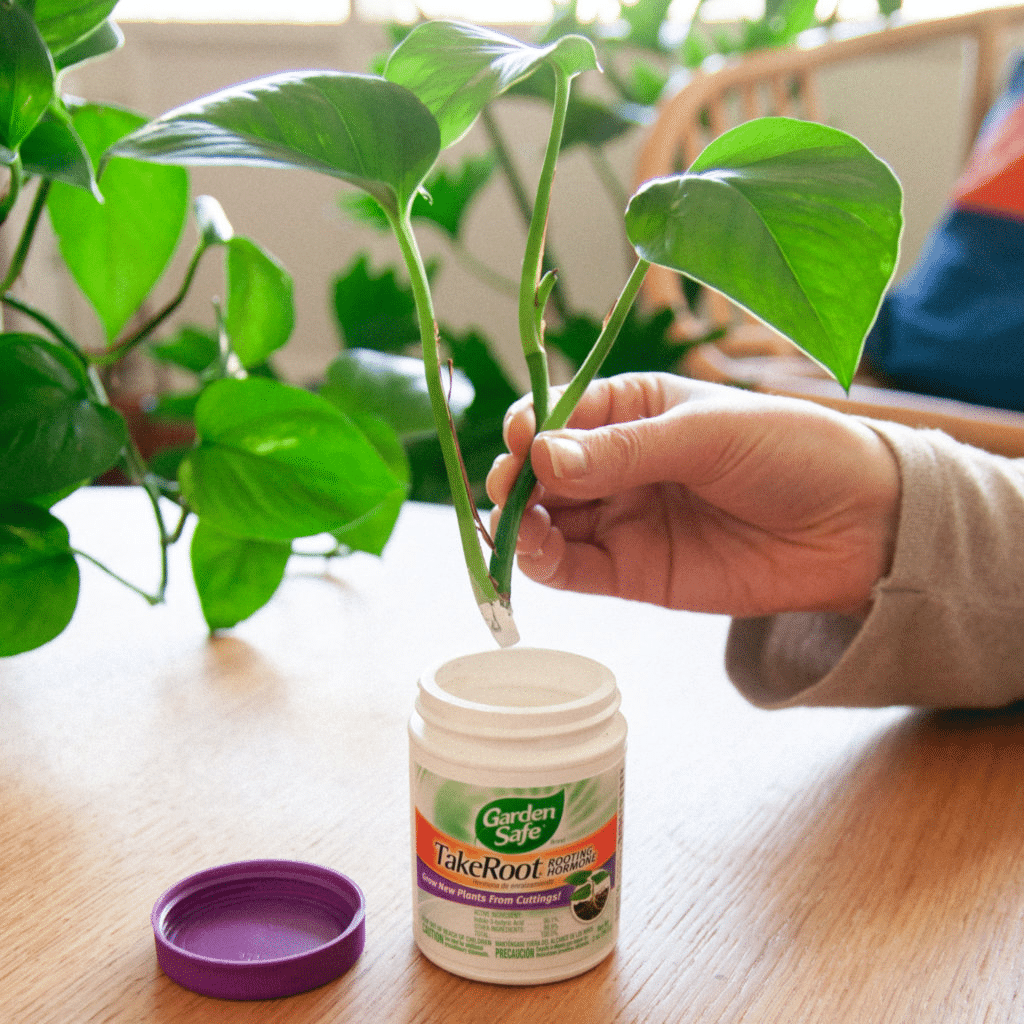
Before planting the cuttings in soil, it’s beneficial to apply a rooting hormone to the cut end of the stem. Rooting hormone is a powder or gel that helps promote rapid root growth in stem cuttings. To apply, simply dip the base of the cutting into the rooting hormone and tap or shake the cutting to remove any excess.
Using rooting hormone, such as rooting hormone powder, can help grow roots faster, giving your new plant a head start on its journey to becoming a thriving, mature plant.
Planting and Caring for Cuttings in Soil
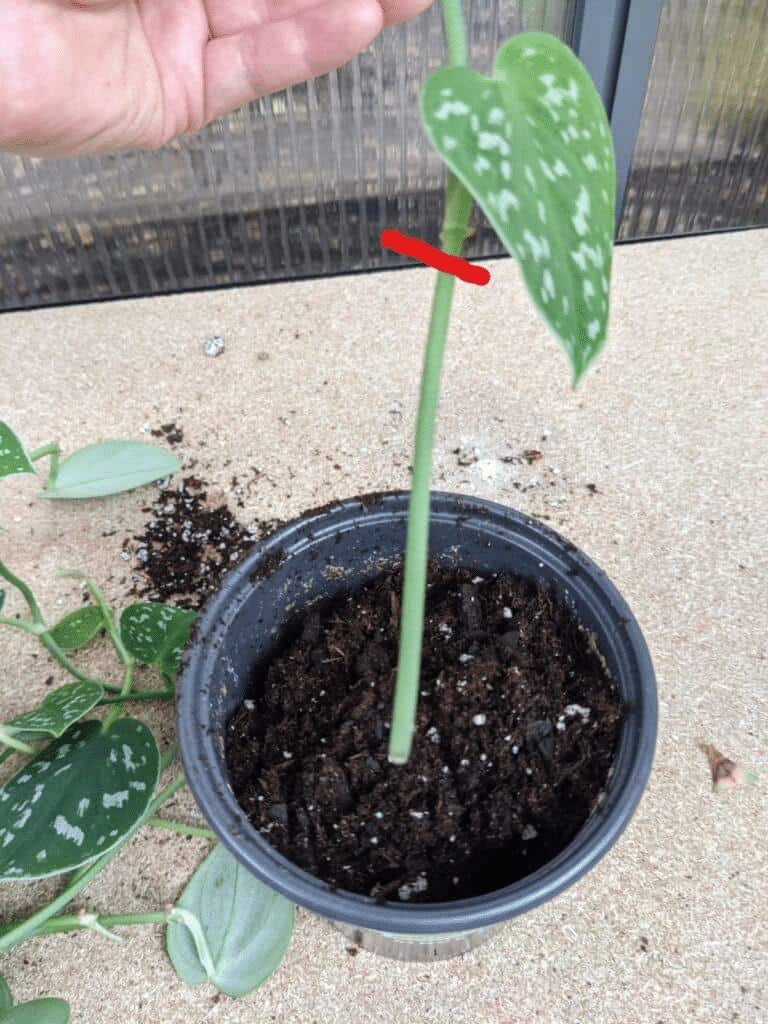
Once you’ve applied rooting hormone to your stem cutting, it’s time to plant it in soil. Choose a small pot with drainage holes and fill it with a well-draining soil mixture, such as a blend of potting soil, coconut coir, and perlite. Place the cutting in the soil, ensuring that the nodes are covered.
Watering is key when caring for cuttings in soil. Make sure to keep the soil moist, but not too wet. Water them every 5-8 days, depending on pot size, soil composition, and temperature. Provide bright, indirect light for optimal growth.
With proper care and fresh potting soil, your Costa Farms Golden Pothos, soil-propagated, will flourish!
Propagating Pothos with Sphagnum Moss
Sphagnum moss propagation is an alternative method preferred by some growers. This method offers a balance between water and soil propagation, providing an excellent environment for root development. So if you’re looking for a new propagation method to try, sphagnum moss might be the perfect choice!

In the following sections, we’ll discuss how to prepare sphagnum moss and plant and care for cuttings in this unique growing medium.
Preparing Sphagnum Moss
Before using sphagnum moss for propagation, it’s essential to rehydrate it. Soak the dry moss in water for 20-30 minutes. Once it’s fully hydrated, gently squeeze out any excess water to ensure the moss is damp but not soaking wet.
Planting and Caring for Cuttings in Sphagnum Moss
Place the prepared cuttings in the moist sphagnum moss, ensuring that the nodes are covered. To maintain consistent moisture in the moss, water it whenever the top begins to dry. Provide bright, indirect light for root development, and avoid exposing the cuttings to direct sunlight.
Again, patience is key. The cuttings will take a few weeks to develop roots in the sphagnum moss. Once they do, you can transfer them to soil and continue caring for your new pothos plants.
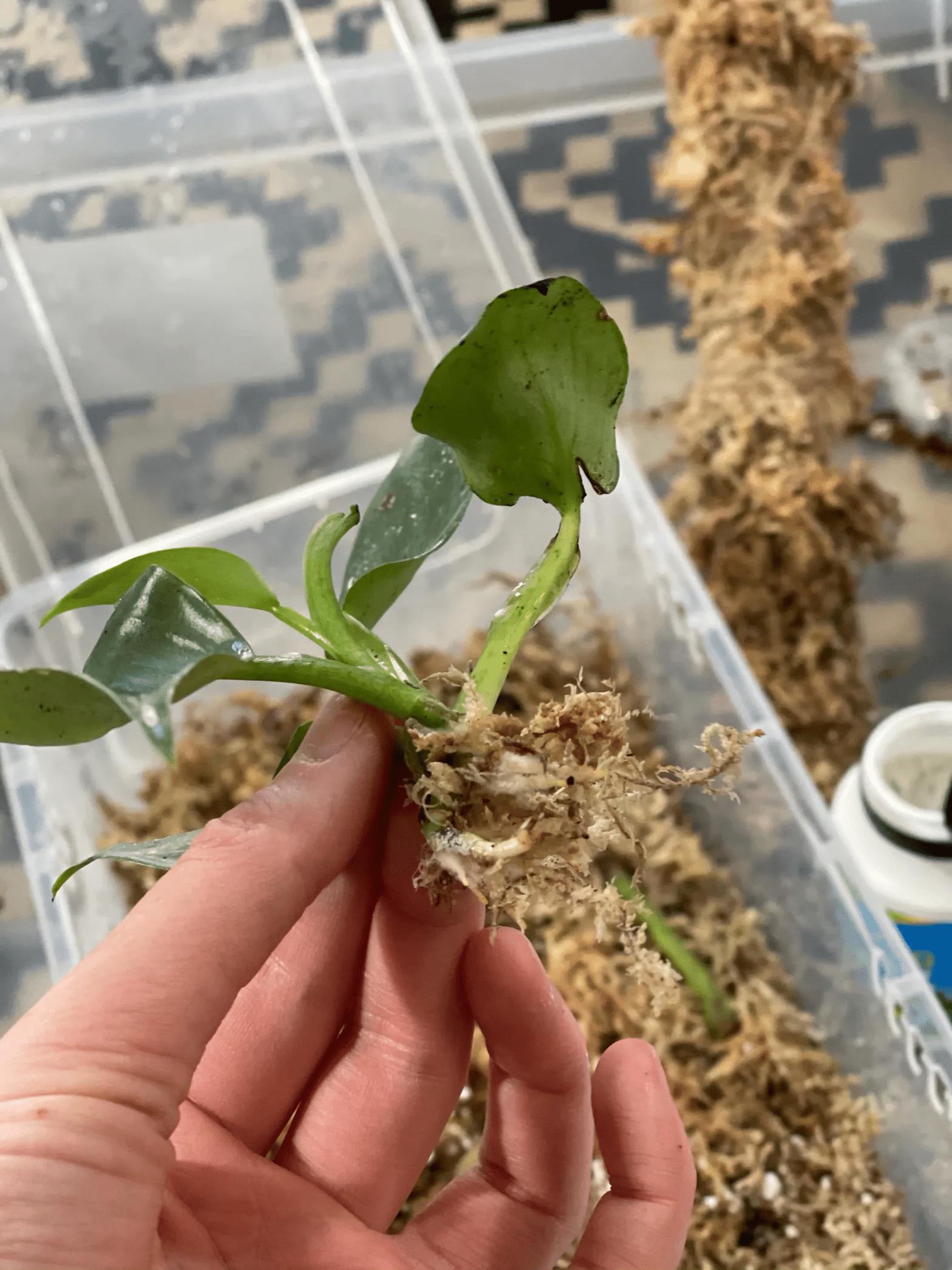
Other Propagation Methods
While water, soil, and sphagnum moss are popular methods for pothos propagation, several other techniques can be used. These include layering, root division, and offsets/runners. Each method has its own advantages and challenges, providing you with multiple options to experiment with and find the one that works best for you.
Layering involves strategically placing a part of a vine with a node in contact with the soil, allowing it to form roots and thrive. Root division is ideal for downsizing a plant that has outgrown its container or expanding your collection with a large plant that can be easily divided. Offsets/runners are lateral shoots that grow horizontally from the main part of the plant, creating new buds.
Exploring these alternative methods can offer exciting new opportunities for expanding your pothos collection and discovering the method that suits your gardening style best.
Troubleshooting Common Propagation Issues

As with any plant propagation, you may encounter some challenges along the way. Some common issues with pothos propagation include overwatering, incorrect light levels, pests and diseases, yellowing leaves, root rot, and failure to root. However, don’t despair! With a little attention and care, you can address these issues and help your pothos thrive.
To address overwatering, reduce the amount of water you give your plant and allow the soil to dry out between waterings. If your pothos isn’t getting enough light, move it to a brighter location or provide supplemental lighting. For pests or diseases, treat your plant with an appropriate pesticide or fungicide.
If the pothos leaves are yellowing, check the soil for nutrient deficiencies and adjust your fertilizing schedule accordingly. For root rot, remove the affected roots and repot the plant in fresh, sterile soil.
To help your pothos root, check the temperature and humidity levels and adjust them as needed, as well as applying a rooting hormone to the cuttings for extra encouragement.
Tips for Pothos Plant Care
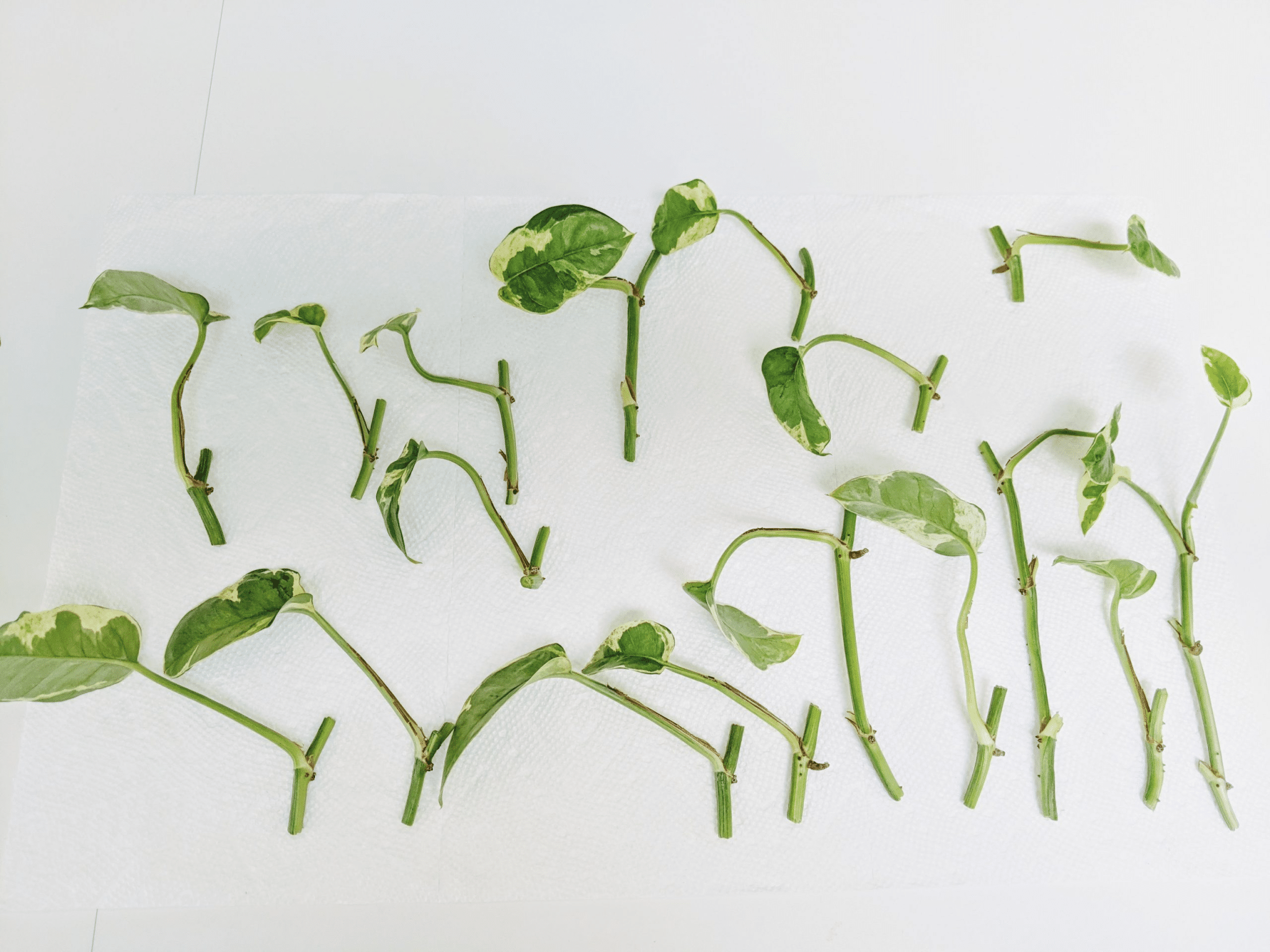
Whether you’re propagating pothos for the first time or expanding your existing collection, it’s essential to provide your plants with the proper care to ensure they grow strong and healthy. Adequate light, proper watering, and regular fertilization are all crucial factors in maintaining a thriving pothos plant.
Remember, pothos plants prefer bright, indirect light and well-drained soil. Keep the soil evenly moist but not soaking wet, and allow it to dry out between waterings. Fertilize your pothos regularly to ensure it receives the nutrients it needs to grow and flourish.
With the right care, your pothos plants will thrive and reward you with a lush, vibrant indoor garden.
Summary
In this blog post, we’ve explored the various methods of propagating pothos plants, including water, soil, and sphagnum moss propagation, as well as alternative techniques like layering, root division, and offsets/runners. By understanding the different propagation methods and how to care for your pothos plants, you can create a lush, thriving indoor garden with ease.
Now that you’re equipped with the knowledge and techniques to propagate pothos plants, it’s time to roll up your sleeves and get started. Embrace the joy of nurturing new life from an existing plant and watch your indoor garden flourish!
Frequently Asked Questions
Where do I cut a pothos to propagate it?
Take stem cuttings of 4-6 inches from the mother plant with at least two nodes and 4+ leaves.
Then, cut just below a root node using sharp and sterilized shears or scissors to propagate your pothos plant.
How long does it take to propagate pothos?
You can be ready to plant your beautiful, vibrant pothos within 4-6 weeks! During this time, keep the cutting in water, vermiculite, or perlite and watch as the roots begin to form. Once there are side branches present, you’re good to go!
Planting your pothos is a great way to add some life to any space.
How long does it take for pothos cuttings to root in water?
With some patience, you’ll be able to enjoy a healthy pothos plant in no time! It usually takes between 7-14 days for your cutting to develop strong roots when placed in water. After that point, you can decide to move the cutting into soil or let it thrive in water with quality liquid fertilizer.
You’ll be surprised at how quickly your pothos blooms!
When is the best time to propagate pothos plants?
Now is the perfect time to propagate pothos plants and enjoy their lush foliage year-round!
Which propagation method results in stronger root systems for pothos plants?
Water propagation is a great way to create strong root systems for pothos plants.
It is a simple process that involves taking a cutting from an existing plant and placing it in water until it develops roots. The roots will then be transplanted into soil.





No Comments